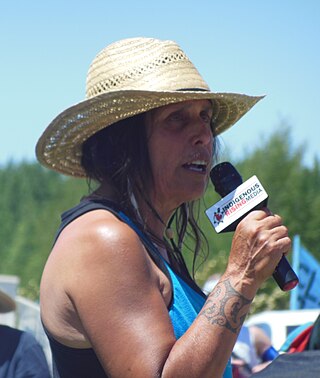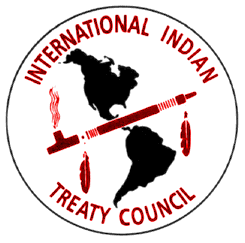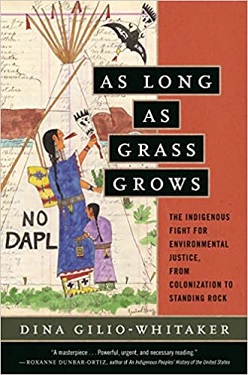
Winona LaDuke is an American economist, environmentalist, writer and industrial hemp grower, known for her work on tribal land claims and preservation, as well as sustainable development.

The American Indian Movement (AIM) is an American Indian grassroots movement which was founded in Minneapolis, Minnesota in July 1968, initially centered in urban areas in order to address systemic issues of poverty, discrimination, and police brutality against American Indians. AIM soon widened its focus from urban issues to many Indigenous Tribal issues that American Indian groups have faced due to settler colonialism in the Americas. These issues have included treaty rights, high rates of unemployment, the lack of American Indian subjects in education, and the preservation of Indigenous cultures.

The Standing Rock Reservation lies across the border between North and South Dakota in the United States, and is inhabited by ethnic "Hunkpapa and Sihasapa bands of Lakota Oyate and the Ihunktuwona and Pabaksa bands of the Dakota Oyate," as well as the Hunkpatina Dakota. The Ihanktonwana Dakota are the Upper Yanktonai, part of the collective of Wiciyena. The sixth-largest Native American reservation in land area in the US, Standing Rock includes all of Sioux County, North Dakota, and all of Corson County, South Dakota, plus slivers of northern Dewey and Ziebach counties in South Dakota, along their northern county lines at Highway 20.
Pan-Indianism is a philosophical and political approach promoting unity, and to some extent cultural homogenization, among different Indigenous groups in the Americas regardless of tribal distinctions and cultural differences.

The International Indian Treaty Council (IITC) is an organization of Indigenous Peoples from North, Central, South America, the Caribbean and the Pacific working for the Sovereignty and Self-Determination of Indigenous Peoples and the recognition and protection of Indigenous Rights, Treaties, Traditional Cultures and Sacred Lands.
Madonna Thunder Hawk is a Native American civil rights activist best known as a member and leader in the American Indian Movement (AIM), co-founding Women of All Red Nations (WARN) and the Black Hills Alliance, and as an organizer against the Dakota Access Pipeline. She established the Wasagiya Najin Grandmothers' Group on the Cheyenne River to help build kinship networks while also developing Simply Smiles Children Village. She also serves as the Director of Grassroots Organizing for the Red Road Institute. Thunderhawk has spoken around the world as a delegate to the United Nations and is currently the Lakota People's Law Project principal and Tribal liaison. She was an international Indian Treaty Council delegate to the United Nations Human Rights Commission in Geneva. Also, a delegate to the U.N. Decade of Women Conference in Mexico City and in the 2001 to the World Conference against Racism in Durban, South Africa.
Tom B.K. Goldtooth is a Native American environmental, climate, and economic justice activist, speaker, film producer, and Indigenous rights leader. He is active in local, national and international levels as an advocate for building healthy and sustainable Indigenous communities based upon the foundation of Indigenous traditional knowledge. Goldtooth has served as executive director of the Indigenous Environmental Network (IEN) since 1996 after serving as a member of the IEN National Council since 1992.

The Dakota Access Pipeline Protests, also known by the hashtag #NoDAPL, were a series of grassroots Native American protests against the construction of the Dakota Access Pipeline in the northern United States that began in April 2016. Protests ended on February 23, 2017 when National Guard and law enforcement officers evicted the last remaining protesters.

Dallas Goldtooth is a Native American (Sioux) environmental activist and performing artist. He is a co-founding member of the 1491s, a Native American sketch comedy group and a member of the cast of the television series Reservation Dogs. He is a Dakota language-instructor, writer, artist, and actor.

LaDonna Brave Bull Allard, known as Tamakawastewin, was a Native American Dakota and Lakota historian, genealogist, and a matriarch of the water protector movement.

Water protectors are activists, organizers, and cultural workers focused on the defense of the world's water and water systems. The water protector name, analysis and style of activism arose from Indigenous communities in North America during the Dakota Access Pipeline protests at the Standing Rock Reservation, which began with an encampment on LaDonna Brave Bull Allard's land in April, 2016.

#NODAPL, also referred to as the Dakota Access Pipeline protests, is a Twitter hashtag and social media campaign for the struggle against the proposed and partially built Dakota Access Pipeline. The role social media played in this movement is so substantial that the movement itself is now often referred to by its hashtag: #NoDAPL. The hashtag reflected a grassroots campaign that began in early 2016 in reaction to the approved construction of the Dakota Access Pipeline in the northern United States. The Standing Rock Sioux and allied organizations took legal action aimed at stopping construction of the project, while youth from the reservation began a social media campaign which gradually evolved into a larger movement with dozens of associated hashtags. The campaign aimed to raise awareness on the threat of the pipeline on the sacred burial grounds as well as the quality of water in the area. In June 2021, a federal judge struck down the Standing Rock Sioux Tribe's lawsuit, but left the option of reopening the case should any prior orders be violated.

Scatter Their Own was a Rock Band by Scott Clifford. In the Lakota language, the tribe name Oglala translates to "scatter one's own", desiring to scatter Lakota perspective throughout the country.
The Line 3 pipeline is an oil pipeline owned by the Canadian multinational Enbridge. Operating since 1968, it runs 1,031 miles (1,659 km) from Hardisty, Alberta, Canada to Superior, Wisconsin, United States.
Deborah Parker, also known by her native name cicayalc̓aʔ, is an activist and Indigenous leader in the United States. A member of the Tulalip Tribes of Washington, she served as its vice-chairwoman from 2012 to 2015 and is, as of July 2018, a board member for Our Revolution and the National Indigenous Women's Resource Center. She is also a co-founder of Indigenous Women Rise.

A land defender, land protector, or environmental defender is an activist who works to protect ecosystems and the human right to a safe, healthy environment. Often, defenders are members of Indigenous communities who are protecting property rights of ancestral lands in the face of expropriation, pollution, depletion, or destruction.
Jasilyn Charger is a member of the Cheyenne River Sioux Tribe and is from Eagle Butte, South Dakota, USA. Charger is a land activist, water protector, community organizer, and advocate for Native American and LGBTQ rights, and a youth founder of the Dakota Access Pipeline protests. They have also protested against the Keystone Pipeline, and were arrested for their non-violent civil disobedience in November 2020.

The Stop Line 3 protests are an ongoing series of demonstrations in the U.S. state of Minnesota against the expansion of Enbridge's Line 3 oil pipeline along a new route. The new route was completed in September 2021, and was operational on 1 October 2021. Indigenous people have led the resistance to the construction of the pipeline, which began following the project's approval in November 2020. Opponents of the pipeline expansion, called water protectors, have established ceremonial lodges and resistance camps along the route of the pipeline. Enbridge has funded an escrow account that law enforcement agencies may draw on for pipeline-related police work. Organizers have arranged marches and occupations of Enbridge construction sites. Following the blockade of an Enbridge pump station on June 7, 2021, nearly 250 people were arrested. Invoking treaty rights, organizers established an encampment at the headwaters of the Mississippi River at a site where Enbridge intends to bury the pipeline.

As Long as Grass Grows: The Indigenous Fight for Environmental Justice, from Colonization to Standing Rock is a 2019 non-fiction book by Dina Gilio-Whitaker. The author details the history of Native Americans in the United States since European colonization, including criticisms of the modern conservation movement as exclusionary to indigenous concepts of land and environmental stewardship, and coverage of the 2010s Dakota Access Pipeline protests at Standing Rock.

Diné CARE is a Diné (Navajo) activist organization that works on environmental, cultural and social justice campaigns, primarily within the Navajo Nation and the immediately surrounding areas. Diné CARE stands for Diné Citizens Against Ruining Our Environment and helped build the early environmental justice movement in the United States. Their work has included opposing the creation of toxic waste infrastructure, polluting energy infrastructure, industrial-scale logging, advocating for compensation for people impacted by uranium mining and weapons development as well as against business practices that facilitate abuse of alcohol in nearby Gallup.














